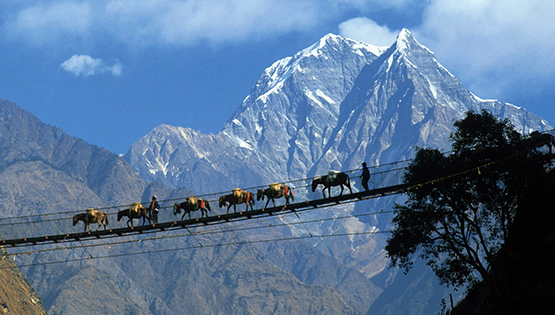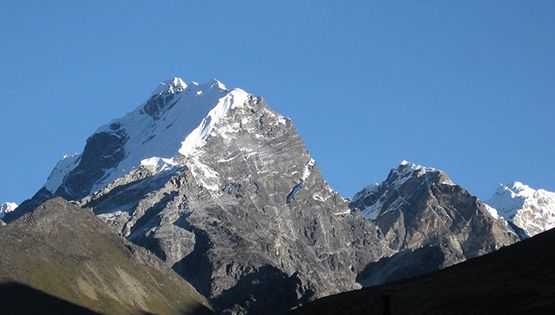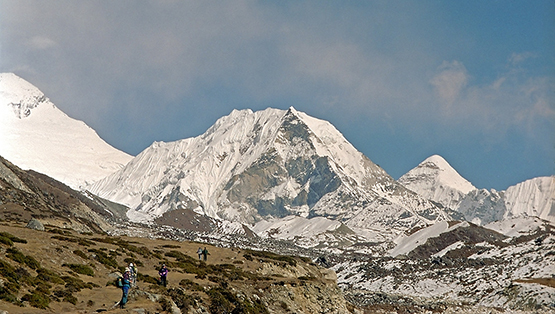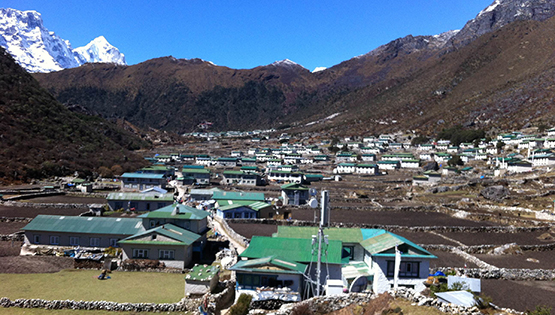Altitude Sickness (AMS)
Altitude Sickness/Acute Mountain Sickness (AMS)
Altitude sickness, also called Acute Mountain Sickness (AMS) generally occurs above 2,500 m (8,000 ft), but serious altitude illness is rare below 3,000 m (10,000 ft). It ranges from a mild headache and weariness to a life-threatening disease, when fluid in the lungs (HAPE) or brain (HACE) is built-up. AMS is caused by the body having difficulty adapting to the lower oxygen level at higher altitudes. Usually this is due to a too quick ascent, and sometimes personal sensitivity. As AMS can be fatal, it is important to know about the disease, its symptoms, how to prevent them and how to treat AMS.
Acute Altitude Sickness
Acute altitude sickness is the mildest and most common form. Patients usually have a (mild) headache and/or less appetite, and nausea. These symptoms are quite common above 3,000 meters (10,000 ft). Nothing to be worried about (yet), but it is important to tell you guide or trekking companion about your symptoms, and keep close watch that they don’t get worse.
Symptoms:
- Headache
- Fatigue
- Dizziness
- Insomnia
- Shortness of breath during exertion
- Nausea
- Decreased appetite
- Swelling of extremities
- Lack of sleep
- Social withdrawal
High Altitude Pulmonary Edema (HAPE)
HAPE occurs when fluid builds up within the lungs, a condition that can make breathing extremely difficult. Onset of HAPE can be gradual or sudden. HAPE typically occurs after more than one day spent at high altitude. If left untreated, it can progress to respiratory collapse and ultimately to death.
Symptoms:
- Shortness of breath at rest
- Extreme fatigue
- Gurgling respirations
- Dry cough or wet cough with frothy sputum
- Possible fever
- Respiratory failure
High Altitude Cerebral Edema (HACE)
Another severe form of altitude sickness is high altitude cerebral edema (HACE), in which fluid builds up within the brain. As the brain swells with fluid, the person’s mental state changes. Loss of coordination, coma, and, finally, death can are the cause if not recognized and treated promptly.
Symptoms:
- Difficulty with balance and coordination
- Hallucinations, lethargy, confusion
- As the brain continues to swell unconsciousness or coma will develop.
How to identify if someone is seriously suffering from AMS, HAPE or HACE:
- Ask the person to close his eyes and bring his finger to the tip of his nose.
- Ask the person to walk in a straight line
- Ask the person to put on pants (put his leg into one of the legs)
If he is not able to do so, the situation is serious!!
How to treat AMS
- In case of mild symptoms, stay at the same altitude. Ascend only when the symptoms have resolved completely
- In case your symptoms are getting worse while resting at the same altitude, descend
- In case of serious symptoms go down immediately! Helicopter rescue may be necessary.
- If the patient is not able to walk (due to serious symptoms) and can’t be carried down, an inflatable high pressure bag (Gamow Bag) can help. The bag restores the oxygen level and air pressure and is used as a treatment in acute situations. Some trekking groups carry a pressure bag, besides they are available in some lodges, especially in the Khumbu/Everest area.
- Never let a patient descend unattended
- If available, consult a doctor, also if symptoms are not yet very serious
How to prevent AMS
The best way to prevent AMS is to ascend gradually. Above an altitude of 3,000 meters (10,000 ft) you should not ascend more than 300 m (1,000 ft) a day. If due to the itinerary this is not possible, a rest day to acclimatize is recommended. Drinking lots of water can help to prevent AMS. Per day, you should be drinking 1 liter of water for every 1,000 meter (3,000 ft) altitude. This means that at an altitude of 4,000 m (12,000 ft), you should be drinking 4 liter of water a day (or tea, juice or other fluids, except alcohol).
More and more people use Diamox (Acetazolamide) as a prophylaxis, to help the body acclimatize more quickly. You start taking Diamox shortly before you start to ascend above 3,000 m (10,000 ft) and continue taking it until you descend again. Consult with your doctor if you consider using Diamox. Persons with allergy to sulfa drugs should not take the drug. Drink extra amounts of water, as Diamox dehydrates the body.


















